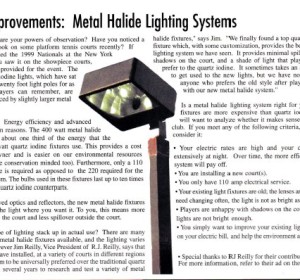R. J. Reilly, Inc. pioneers metal halide court lighting systems
PTM carried the following story on the new development:
How strong are your powers of observation? Have you noticed a different look on some platform tennis courts recently? If you attended the 1999 Nationals at the New York Athletic Club, you saw it on the showpiece courts, which R.J. Reilly provided for the event. The traditional quartz iodine lights, which have sat perched atop the twenty foot light poles for as long as most players can remember, are slowly being replaced by slightly larger metal halide fixtures.
Why the change? Energy efficiency and advanced optics are the main reasons. The 400 watt metal halide fixtures only use about one third of the energy that the traditional 1500 watt quartz iodine fixtures use. This provides a cost savings to the owner and is easier on our environmental resources (paddle players are conservation minded too). Furthermore, only a 110 amp power service is required as opposed to the 220 required for the quartz iodine system. The bulbs used in these fixtures last up to ten times longer than their quartz iodine counterparts.
Because of improved optics and reflectors, the new metal halide fixtures can better direct the light where you want it. To you, this means more consistent light on the court and less spillover outside the court.
How does this type of lighting stack up in actual use? There are many different types of metal halide fixtures available, and the lighting varies for each one. However Jim Reilly, Vice President of R.J. Reilly, says that the fixtures they have installed, at a variety of courts in different regions of the country, seem to be universally preferred over the traditional quartz iodine. “We took several years to research and test a variety of metal halide fixtures,” says Jim. “We finally found a top quality shoebox style fixture which, with some customization, provides the best platform tennis lighting system we have seen. It provides minimal spillover, virtually no shadows on the court, and a shade of light that players indicate they prefer to the quartz iodine. It sometimes takes an adjustment period to get used to the new lights, but we have not yet encountered anyone who prefers the old style after playing several times with our new metal halide system.”
Source: Platform Tennis Magazine, Issue #2, November, 1999




